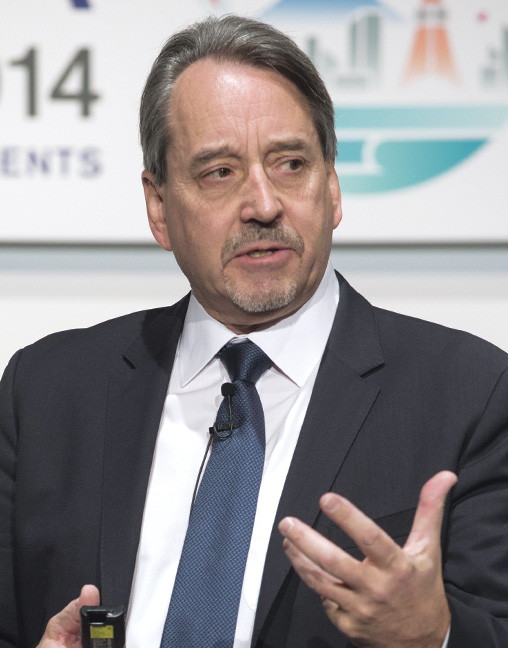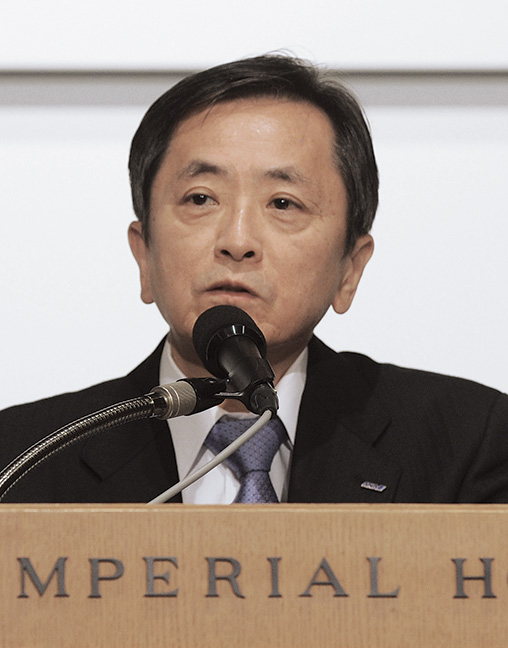Main Story
PROFITS BECKON IN 2015?
Delegates at last month’s Association of Asia Pacific Airlines (AAPA)’s annual Assembly heard of determined progress in improving aircraft tracking systems – and that cargo was on an upswing. But speakers warned that regional over-capacity, fuel price volatility, new taxes, infrastructure issues and health pandemics were challenges to profitability.
December 1st 2014
Relentless growth has not translated into profits in the last year, the director general of the Association of Asia Pacific Airlines (AAPA), Andrew Herdman, told delegates at the association’s 58th annual Assembly of Presidents last month, held this year in Tokyo. Read More »
 |
But 2015 is looking better, he cautiously predicted. For many of the region’s airlines, Herdman said, a quick return to profitability is being made harder by the economic and political uncertainties prevailing across the world. The way forward for Asia-Pacific aviation “will be a quiet one” with “slight misjudgments” discreetly corrected by individual airlines, he said.
“Maybe less (aircraft) deliveries and maybe [more] retirements. The turnaround could be underway already. The anecdotal evidence is that it has started, but it is not yet evident in terms of yield.”
In the meantime, the world’s single biggest aviation market is dealing with the fact that a combination of thriving passenger traffic (5% plus) and scores of new aircraft had not produced substantial profits for the region’s airlines.
“Large aircraft orders and deliveries in the Asia-Pacific to both full-service carriers and their low-cost rivals have resulted in capacity growth that is 1%-2% ahead of demand. This has forced price reductions, with a knock-on effect on balance sheets. Asia-Pacific carriers are operating close to break even and the LCCs are not much different,” Herdman said.
The failure to meet acceptable profit targets – with a few notable exceptions - wasn’t the only concern for the industry, the AAPA said. Airlines are frustrated by such issues as varying Passenger Rights legislation as well as the costs and the shortfalls of infrastructure and the public’s shifting attitudes to airline safety.
Calling the shooting down of MH17 (on July 18), “a military failure”, Herdman said the Assembly’s board had passed a resolution that sought improved intelligence sharing for flights travelling over conflict zones. A robust, safe commercial aviation system required the sharing of information of where and when it is safe to fly, he said.
All Nippon Airways (ANA) president and chief executive, Osamu Shinobe, who chaired the Assembly, said in recent years the environment surrounding the sector had changed dramatically. “LCCs have been increasing. Middle Eastern carriers have been demanding more and more air rights. Airlines have been buying stakes in each other and alliances have been expanded,” he said.
 |
| 'MH17 was a military failure. You are safe because governments enforce codes that say you don’t shoot down commercial aircraft' |
| Andrew Herdman Director general of the Association of Asia Pacific Airlines |
“Due to the nature of our business, airlines are directly exposed to environmental risks such as wars and disease. But ensuring safety and providing customers with a pleasant flight remain the mission of all airlines.”
In this environment, it was critical the 16 member airlines of the AAPA worked together, Shinobe said. “According to forecasts, the market is set to grow. The task we Asia-Pacific airlines face will be immense. Under the umbrella of the AAPA, I hope that we will walk together to develop our airline business.”
In his keynote address to the Assembly, the International Air Transport Association (IATA) director general and CEO, Tony Tyler, identified continuous safety enhancement, the availability of cost-efficient infrastructure and environmental responsibility as critical factors to ensure the Asia-Pacific realized the enormous economic and social benefits of air connectivity.
“It is no understatement to say that air connectivity underpins modern economies. Aviation and aviation-enabled tourism accounts for more than 24 million jobs and over $500 billion in economic activity across the Asia-Pacific. And that contribution has tremendous potential to grow,” he said.
IATA forecasts some 3.3 billion passengers are expected to board flights this year, with that number predicted to increase to 7.3 billion by 2034. “By 2034, we expect nearly half of all air travel (some 2.9 billion journeys) will touch the Asia-Pacific (up from around 40% today), Tyler said.
“Over the next 20 years, the Asia-Pacific is forecast to account for about two-thirds of global growth. Aviation is an industry with tremendous potential and the Asia-Pacific is leading the industry’s growth. But there will be challenges to become ever safer, to provide cost-efficient infrastructure and to ensure environmental responsibility,” said Tyler.
Both he and Herdman stressed flying remains very safe. “On very rare occasions, accidents do happen. In 2013, there were 16 fatal accidents among 36.4 million commercial flights. And the two tragic accidents involving Malaysia Airlines this year are a sad reminder that safety is always a constant and ever-evolving challenge,” said Tyler.
 |
One development that has brought smiles to the faces of airline executives in recent weeks is the dramatic drop in the price of fuel, down almost 40% since June. However, Herdman said the reduced price did not necessarily translate into larger profits. The decline helps airlines, he said. but “we’d actually welcome lower oil prices not so much as a windfall for the industry, but as an overall benefit”.
Malaysia Airlines chief executive, Ahmad Jauhari Yahya, said. “Any saving on fuel is greatly welcomed. But Andy is right. We are still subject to market competition and you have to manage fares. For airlines it’s all about getting the most efficient operation out of the aircraft you fly. “Fuel is always going to be a cost and it’s how you can manage that cost. Some airlines have gone into hedging, some have not. Ultimately, fuel efficiency is something every airline needs to deal with, either through new technology, new aircraft or just the way you fly.”
Cathay Pacific Airways chief operating officer, Rupert Hogg, said fuel was 40% of Cathay’s operating costs. “We need efficient aircraft. We hedge as insurance because the one scenario we can’t have is our operating costs going up. We are quite well hedged,” he said.
“We take the view low fuel costs are a good thing, basically because they put more disposable income in peoples’ pockets. It’s less of a tax on the economy and that means there is more inclination for people to fly.”
“AAPA carriers operate in a highly competitive environment and are experiencing pressure on profitability,” said Herdman. “Still, a lot could be done to improve the regulatory framework for the industry.
 |
| IATA boss Tony Tyler and Garuda Indonesia president Emirsyah Satar prove they’ve got rhythm |
“Unfortunately, some governments still have little regard for the burdens that poorly-conceived policies place on the air transport industry. Unjustified taxes and regulations negatively impact the travelling public by making air travel less affordable. Excessive regulation is also a disincentive to innovation by the airlines.”
He also criticized “a series of uncoordinated and reactive restrictions” introduced by governments in the face of a perceived health pandemic threat from the Ebola virus. Many still remember the disastrous H1N1 Influenza pandemic of 2009, which saw empty aircraft flying the region’s skies, he said. The Ebola outbreak “has not had an impact on airlines in the region”, but the AAPA and other global airline bodies want more consultation with the World Health Organization (WHO).
This should include a “focus on outbound screening” from the departure airport, rather than inbound screening at destinations. Herdman advised governments to “seriously consider” the implications of potentially disruptive travel advisories.
As for making more money, AAPA airline chiefs agreed an early return to profitability is a priority. Herdman said airlines are reviewing their fleet and network development plans, whilst maintaining a tight rein on costs to restore profitability.
“On a more positive note, after many years of stagnant market conditions, air cargo volumes are picking up, which is news welcomed by Asian airlines as air freight accounts for 38% of the global air cargo market,” Herdman said.
| Governments must share information on safe flying The director geneal of the Association of Asia-Pacific Airlines, Andrew Herdman, said the Assembly’s board had passed a resolution that sought improved intelligence sharing for flights travelling over conflict zones. A robust, safe commercial aviation system required the sharing of information of where and when it is safe to fly, he said. “But trying to explain that need for diversity of information sharing (to governments) is difficult. How it should be done and if it should be centralized is still under discussion. The strength of the system is that it is a shared system and it is robust,” he said. An ICAO-led task force was set up after MH17, combining state and industry experts worldwide, to look at airspace security issues and how to improve information sharing. “MH17 was a military failure. You stay safe because governments enforce codes that say you don’t shoot down commercial aircraft. I can think of just four times that this has happened, but when it happens it’s a catastrophe and it’s avoidable. But this is a military challenge,” said Herdman. Airlines must be able to make their own individual assessments on where and when to fly within the constraints applied by governments. It was essential, therefore, for information on potentially unsafe routes or areas to be shared and declared, he said. |